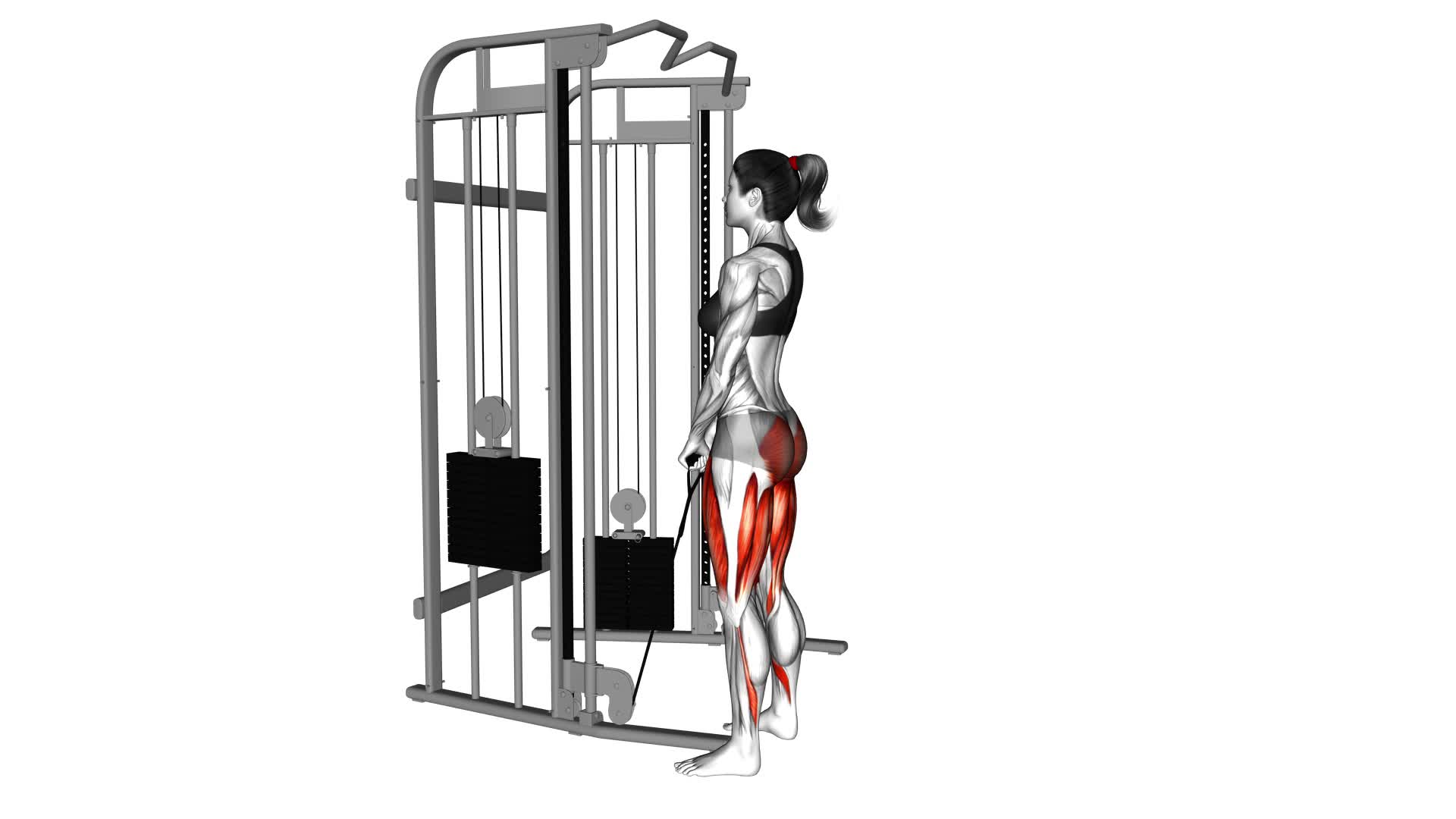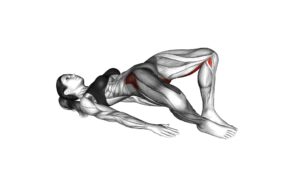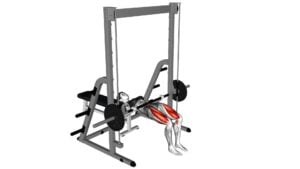Cable Standing Hip Thrust (female) – Video Exercise Guide & Tips

Looking to strengthen your glutes and improve your overall lower body strength? Look no further than the cable standing hip thrust.
Watch This Exercise Video
In this exercise, you'll be using a cable machine to target your glutes, hamstrings, and core. It's a challenging yet effective move that can help you build a strong and toned lower body.
In this article, you'll find a video exercise guide and helpful tips to ensure proper form and technique.
Let's get started!
Key Takeaways
- Cable standing hip thrusts target and enhance the glute muscles, specifically the gluteus maximus.
- Engaging the core muscles during the exercise stabilizes the torso and strengthens the abs and lower back.
- Proper form and technique involve focusing on engaging the glute muscles, maintaining a neutral spine, and using a cable machine with an adjustable pulley system.
- Variations and progressions, such as single-leg hip thrusts and using a resistance band, can increase glute activation, stability, and overall challenge.
Benefits of Cable Standing Hip Thrust
You will experience several benefits when incorporating cable standing hip thrusts into your workout routine.
This exercise targets the glute muscles, specifically the gluteus maximus, which is the largest muscle in your buttocks. By strengthening and toning these muscles, you can enhance the appearance of your backside and improve your overall lower body strength.
One of the main benefits of cable standing hip thrusts is that they provide a greater range of motion compared to traditional hip thrusts performed with a barbell. The cable allows you to move your hips through a full range of motion, which targets the glutes more effectively. Additionally, the cable provides constant tension throughout the movement, maximizing muscle activation and promoting muscle growth.
Another advantage of cable standing hip thrusts is that they engage your core muscles. As you thrust your hips forward, you must stabilize your torso, engaging your abs and lower back muscles. This not only helps to strengthen your core, but it also improves your balance and stability.
Incorporating cable standing hip thrusts into your training routine can also improve your performance in other exercises. The hip thrust motion translates well to activities that require explosive hip power, such as sprinting, jumping, and lifting heavy objects.
Proper Form and Technique
To perform cable standing hip thrusts with proper form and technique, focus on engaging your glute muscles throughout the movement. This exercise is highly effective for targeting the glutes and can help strengthen and tone your lower body.
One common misconception is that this exercise only targets the hips, but in reality, it primarily works the glute muscles.
To start, attach a cable to a low pulley and stand facing away from the machine. Place the cable around your waist and take a step forward to create tension. Keep your feet shoulder-width apart and your knees slightly bent.
As you thrust your hips forward, squeeze your glutes to lift your body up and back. Be sure to maintain a neutral spine and avoid overarching your lower back.
To make the exercise more challenging, you can use heavier weights or perform single-leg cable standing hip thrusts.
Remember to always listen to your body and use proper form to get the most out of this exercise.
Equipment and Setup
Attach the cable to a low pulley and position yourself facing away from the machine. To perform the cable standing hip thrust, you'll need a cable machine with an adjustable pulley system. Ensure that the cable is securely attached to the low pulley and that there's enough space behind you to move freely.
Start by standing with your feet shoulder-width apart and your knees slightly bent. Grab the cable handle with both hands and hold it against your lower abdomen. This will be your starting position.
Next, push your hips back and hinge forward at the waist while keeping your back straight. Allow your arms to extend in front of you, maintaining tension on the cable. Take a deep breath and engage your core.
From this position, drive your hips forward and squeeze your glutes as you stand up tall. Your body should form a straight line from your head to your knees. Hold for a moment, then slowly return to the starting position.
Remember to maintain control throughout the movement and avoid using momentum. Keep your core engaged and focus on using your glutes to power the thrust. Adjust the weight on the cable machine as needed to challenge yourself.
Now you're ready to perform the cable standing hip thrust with the proper equipment and setup.
Variations and Progressions
To progress the cable standing hip thrust, explore different variations to target your glutes and challenge your muscles further. One advanced modification is to perform the exercise with a single leg. This variation not only increases the activation of your glutes but also improves stability and balance. Start by standing facing away from the cable machine, with one foot slightly in front of the other. Attach the ankle cuff to the working leg and hold onto a stable object for support. From this position, perform the hip thrust by driving your working leg back and extending your hips forward. Remember to keep your core engaged and maintain a neutral spine throughout the movement.
Another variation to consider is the cable standing hip thrust with a resistance band. Wrap a resistance band around your thighs, just above your knees, to add extra resistance and intensify the glute activation. This modification targets the outer glutes and challenges your muscles in a different way. To perform this variation, follow the same steps as the basic cable standing hip thrust, but focus on pushing your knees outward against the resistance band as you extend your hips.
By incorporating these advanced modifications, you can take your cable standing hip thrust to the next level and maximize your glute activation.
Now, let's move on to the next section and discuss common mistakes and how to avoid them.
Common Mistakes and How to Avoid Them
To ensure proper form and maximize the effectiveness of the cable standing hip thrust, it's important to be aware of common mistakes and how to avoid them. By avoiding these mistakes, you can prevent injury and get the most out of this exercise.
One common mistake is using too much weight. It's important to start with a lighter weight and gradually increase it as your strength improves. This will help you maintain proper form and avoid straining your muscles.
Another mistake isn't engaging your core. To avoid this, focus on squeezing your abs and glutes as you perform the movement. This will help stabilize your body and prevent any excessive strain on your lower back.
Finally, beginners may find it challenging to balance during the exercise. To modify the cable standing hip thrust for beginners, you can start by using a stability ball against a wall or a bench. This will provide additional support and help you maintain proper form until you build up enough strength and stability to perform the exercise without assistance.
Frequently Asked Questions
How Many Sets and Reps Should I Do for the Cable Standing Hip Thrust Exercise?
For the cable standing hip thrust exercise, it's important to focus on proper form and technique. Start with a weight that challenges you but allows you to maintain good form. Aim for 3-4 sets of 8-12 reps.
As you get stronger, you can increase the weight and decrease the reps. Remember to engage your glutes and core, and avoid arching your back.
Experiment with different variations to target different muscle groups.
Can Men Also Perform the Cable Standing Hip Thrust Exercise?
Yes, both women and men can perform the cable standing hip thrust exercise together.
It's a great exercise for targeting the glutes and strengthening the lower body.
When performing this exercise, make sure to use proper form and start with a weight that challenges you but allows you to maintain control and stability.
Remember to adjust the cable height and weight to suit your individual fitness level.
What Are Some Alternative Exercises That Target the Same Muscles as the Cable Standing Hip Thrust?
If you're looking for alternative exercises that target the same muscles as the cable standing hip thrust, there are a few options you can try.
Some good choices include barbell hip thrusts, glute bridges, and single-leg hip thrusts.
These exercises also activate your glutes and help strengthen your hip muscles.
They can be done with equipment or just using your body weight.
Incorporating these exercises into your routine can provide similar benefits to the cable standing hip thrust for glute activation.
Is It Necessary to Use a Cable Machine for the Standing Hip Thrust Exercise, or Can It Be Done With Other Equipment?
Yes, it's possible to do the standing hip thrust exercise with other equipment besides a cable machine. While the cable machine offers certain benefits like constant tension and resistance, you can still target the same muscles using alternatives like resistance bands, dumbbells, or even bodyweight.
It's important to choose a variation that suits your fitness level and allows you to maintain proper form. Experiment with different equipment to find what works best for you.
Can the Cable Standing Hip Thrust Exercise Help Improve Athletic Performance in Sports Such as Running or Jumping?
The cable standing hip thrust exercise can be a beneficial addition to your athletic performance training. By targeting the glutes and hip muscles, it can help improve power, speed, and explosiveness in movements like running and jumping.
This exercise activates the muscles used in these sports, allowing for greater force production and overall performance. Incorporating the cable machine adds resistance, making the exercise more challenging and effective.
Conclusion
In conclusion, the cable standing hip thrust is a highly effective exercise for targeting the glutes and improving lower body strength.
It can be performed with a cable machine and proper form is crucial to prevent injury and maximize results.
There are various variations and progressions that can be incorporated to continuously challenge the muscles.
By avoiding common mistakes, such as using excessive weight or not maintaining proper alignment, you can ensure a safe and effective workout.

Author
Years ago, the spark of my life’s passion ignited in my mind the moment I stepped into the local gym for the first time. The inaugural bead of perspiration, the initial endeavor, the very first surge of endorphins, and a sense of pride that washed over me post-workout marked the beginning of my deep-seated interest in strength sports, fitness, and sports nutrition. This very curiosity blossomed rapidly into a profound fascination, propelling me to earn a Master’s degree in Physical Education from the Academy of Physical Education in Krakow, followed by a Sports Manager diploma from the Jagiellonian University. My journey of growth led me to gain more specialized qualifications, such as being a certified personal trainer with a focus on sports dietetics, a lifeguard, and an instructor for wellness and corrective gymnastics. Theoretical knowledge paired seamlessly with practical experience, reinforcing my belief that the transformation of individuals under my guidance was also a reflection of my personal growth. This belief holds true even today. Each day, I strive to push the boundaries and explore new realms. These realms gently elevate me to greater heights. The unique combination of passion for my field and the continuous quest for growth fuels my drive to break new ground.







